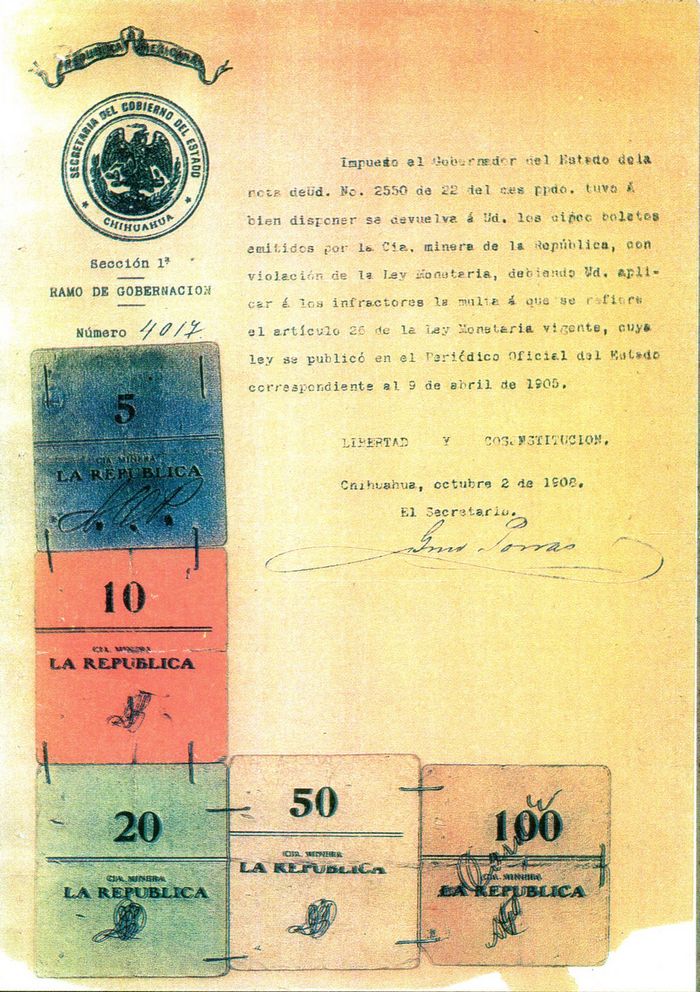A decade of abuse
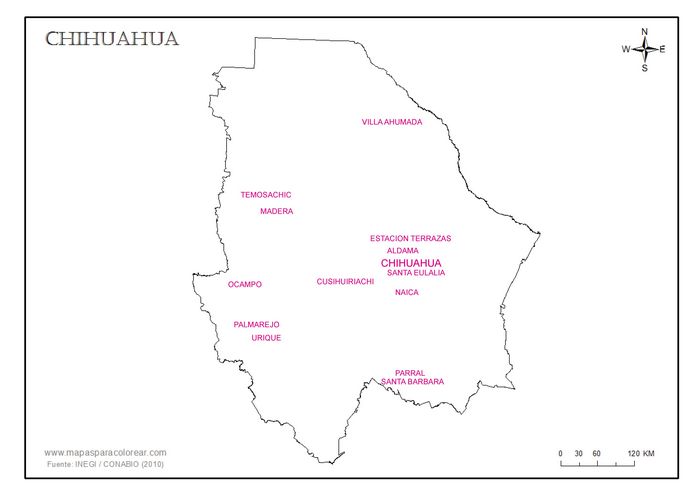 On 30 November 1889 President Porfirio Díaz banned the use of tokens and similar devices after 1 July 1890 and the monetary reforms of 1905 again prohibited their use and supposedly led to their withdrawal but thereafter there were numerous examples of private issues. During the first decade of the new century Silvestre Terrazas' newspaper El Correo de Chihuahua constantly campaigned against the practice of company stores (tiendas de raya) and the state government on several occasions, on 19 June 1905Periódico Oficial, Año XXV, Núm. 38, 22 June 1905, on 18 September 1908Periódico Oficial, , 20 September 1908; Chihuahua Enterprise, 26 September 1908 and 30 March 1909Periódico Oficial, , 8 April 1909 issued circulars to the jefes políticos instructing them be more vigilant and strict in seeing that corporations and business concerns did not violate the law and to report infringements to the governor.
On 30 November 1889 President Porfirio Díaz banned the use of tokens and similar devices after 1 July 1890 and the monetary reforms of 1905 again prohibited their use and supposedly led to their withdrawal but thereafter there were numerous examples of private issues. During the first decade of the new century Silvestre Terrazas' newspaper El Correo de Chihuahua constantly campaigned against the practice of company stores (tiendas de raya) and the state government on several occasions, on 19 June 1905Periódico Oficial, Año XXV, Núm. 38, 22 June 1905, on 18 September 1908Periódico Oficial, , 20 September 1908; Chihuahua Enterprise, 26 September 1908 and 30 March 1909Periódico Oficial, , 8 April 1909 issued circulars to the jefes políticos instructing them be more vigilant and strict in seeing that corporations and business concerns did not violate the law and to report infringements to the governor.
In 1905 a company was fined 500 pesos for using scrip and El Correo de Chihuahua warned other companies to give up the practice. Some firms, it said, issued boletos because of a shortage of fractional currency whilst others were not content with that but also imposed a charge of 10 to 15 per cent to cash their scripEl Correo de Chihuahua, 2 December 1905. In 1908 the Chihuahua Enterprise reported that some companies had recently violated the law and that the federal government had fined them to the limitChihuahua Enterprise, 26 September 1908.
Although apart from La República (infra) no notes remain from this period there are several other references.
Villa Ahumada
In October 1911 it was reported that Luis Terrazas was paying the workers on his hacienda at Villa Ahumada fifty centavos a day, not in cash but in valesEl Correo de Chihuahua, 10 October 1911. Worthington, op. cit., lists a trade token for the Hacienda de Encinillas: TIENDA DE RAYA / CHIHUAHUA / MEX. / ENCINILLAS BUENO POR / $1.00 / MERCANCIAS.
Madera
Compañia de Madera
In March 1908 the Chihuahua weekly, El Universo, reported on the dire situation in Madera, where work had dried up. Even worse was that the company paid its workers with vales, which were used to buy goods in the company’s stores at exorbitant prices. If the workers managed to exchange their vales for hard cash, they only received 50% of their nominal value. Many of the workers had been tempted to Madera by the thought of the good wages that were paid there, but now found that they had to stay because they lacked the means to leave. El Universo thought that, as payment in vales was illegal, the authorities should intervene and put a stop to the practiceEl Universo, 22 March 1908.
In August 1908 the company closed down all its operations and posted a notice that it would pay only 20% of the wages it owed, in cheques drawn on the Banco de Sonora in Ciudad Chihuahua. Troops were called in to counter any disturbancesEl Correo de Chihuahua, 3 August 1908. In September 1908 President Díaz imposed on the Sierra Madre Land Lumber Company a fine for issuing vales ó boletos[image needed] similar to that imposed on the Greene Gold Silver Company (infra). The company had put more than $20,000 in these boletos into circulationLa Patria, 19 September 1908. Presumably this refers to the same company,
On 14 June 1911 the employees of the Compañia de Madera petitioned Governor González over the system of chits (boletos or tiquetes) usable only in the tienda de raya or butcher's shop, the high prices, poor quality and lack of goods. Payment had originally been made on a daily basis but had changed to monthly because of the disruption to railway traffic. Now that the trains had resumed, the company had not reverted to the earlier practice because of the benefits of the new systemEl Correo de Chihuahua, 24 June 1911. Within a few days the company and its employees resolved their differences: the management began paying wages in cash, daily instead of weekly in the workshops and weekly instead of monthly in the sawmills, and reduced prices in the company store to match those in the capitalEl Correo de Chihuahua, 20 June 1911: 26 June 1911: 15 July 1911. Almada (Vida, proceso y muerte de Abraham González, Mexico, 1967) mentions a a strike in July 1911 at the Anglo-American Madera Lumber Company, because of the tienda de raya and the fact that the company had given the Chinese a monopoly over the sale of fruit and vegetables. González gave instructions that the company cover their wages in cash (en efectivo), and allow employees to shop at the tienda de raya, if it was in their interests, or at any of the other establishments. This might refer to the same dispute.
Temósachic
Greene Gold Silver Company
This company was one of those owned by the American entrepreneur William Cornell Greene. Greene received his first concessions in 1902 and in March 1906 was granted a concession to establish a processing plant in Concheño and to run a railway from Guerrero to Rayón and a road from Temósachic to Concheño. In April 1907 the company was granted a further concession for mines, processing plants, electric plants, roads, sueldos de empleados and tiendas de raya in the districts of Galeana, Guerrero and Rayón.
AlmadaFrancisco R. Almada, Apuntes Históricos del Cantón Rayón, Chihuahua, 1943 states that after Greene was bankrupted in 1908 the company had trouble payings its wages. After the local jefe político, Profesor José María Rentería, reconciled the parties, the company paid a percentage of the outstanding wages in cash and the rest in goods from the tienda de raya, which third parties bought off the workers for three-quarters of their value.
In September 1908 the Greene Gold-Silver Company was fined the maximum possible by the Secretaría de Hacienda for using a libreta to pay its workersEl Imparcial; La Gaceta de Guadalajara, 6 September 1908. Another description in La Iberia, 6 September 1908 and El Diario, 7 September 1908 said the fine was for using vales o cheques por mercancias to pay its workers in Ocampo and Concheño, though the wording had been drafted by the Secretario or Sub-secretario de Hacienda in Mexico City to comply as far as possible with the lawACCCC, folder 5, letter from Young to L. D. Ricketts, 8 September 1908. This might have been as a result of El Universo’s report.
No notes are known to exist though specimens for coupons used in the tienda de raya of Greene's Cananea Consolidated Copper Company in neighbouring Sonora are known (see Cananea).
Bocoyna
Chihuahua Lumber Company
The Chihuahua Lumber Company established the first mechanised sawmill in the state at San Juanito, Bocoyna.
In September 1908 President Díaz imposed a fine of $250 on the company for using vales-tarjetas[image needed] to pay the workers in the sawmill at Cuesta PrietaEl Tiempo, Año XXVI, Núm. [ ]74, 25 September 1908.
Estación Terrazas
Negociación Minera de Rio Tinto
In January 1909 the Negociación Minera de Rio Tinto, Estación Terrazas, about 60 kilometres from the state capital, was reported to be paying their workers with valesEl Correo de Chihuahua, 6 January 1909. Two months later another newspaper claimed that more than 200 workers at the mine were victims of the predations of the owner of the tienda de raya, who operated with boletas during the month and charged extortionate prices so that on payday the workers did not receive a centavo but remained in debtEl Pais, Mexico, 20 March 1909.
Aldama
La Gloria mine
In 1908 at the foreign-owned La Gloria mine, in Placer de Santo Domingo, Aldama, about 60 kilometres north-east of Ciudad Chihuahua, the supervisor paid the workers with chits (cartas ordenes) drawn on an American, resident in the Hotel Robinson, Chihuahua. These chits did not carry the legally required counterstamp (marca) El Correo de Chihuahua, 11 July 1908.
Las Plomosas mine
El Correo de Chihuahua originally claimed that at the Las Plomosas mine, Aldama, they had the same system of chits as La Gloria and, because of the economic crisis, workers had not been paid for three monthsEl Correo de Chihuahua, 11 July 1908. However, a fortnight later the paper ran a retraction: it said that it had been informed that the miners were well treated and well paid, not in vales but in cash, and were not obliged to make their purchases in the company’s tienda de rayaEl Correo de Chihuahua, 26 July 1908. So that’s alright, then.
Santa Eulalia
In 1906 three hundred miners in Santa Eulalia petitioned the state government to stop their companies giving them chits (vales) to be used in specified stores because of the high prices that these stores charged. By September, as a result, they no longer had to buy their goods at the tiendas de raya and their lifestyle improved as a consequenceEl Correo de Chihuahua, 10 September 1906.
Naica
José de Stefano
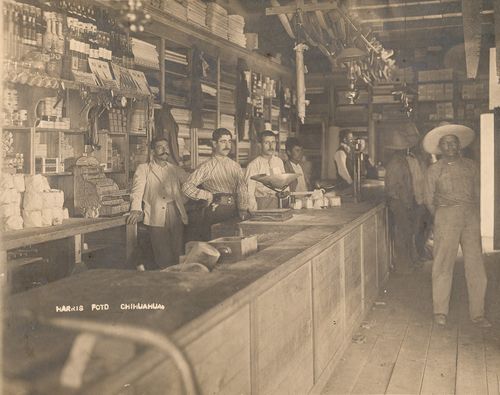
José de Stefano (wearing the striped shirt} in the Tienda La Bella Napoli, 1910
(courtesy La Fototeca del Centro INAH)
Naica is a mining community about 22 miles south of Delicias in south-east Chihuahua. In 1910 it had two thousand inhabitants, mostly employees of the Compañías Explotadora de Naica, Compañia Minera de Lepanto, Compañia Minera de Naica and the Mighty Mountain Mining Company.
The Italian Jose de Stephano listed himself as a miner and merchant in the 1910 Album del Centenario. As a miner, he was president of the Compañía Minera de Lepanto (and Chihuahua representative for the Compañía Minera Fundidora y Afinadora de Monterey)The Mexican Herald, 22 January 1908 and as a merchant, owner of the wholesale and retail store "Tienda Lepanto", which employed six staffAnuario Estadístico del Estado de Chihuahua, 1909, no doubt the same as the "Tienda La bella Napoli".
In 1909 the Secretaría de Hacienda fined de Stefano five hundred pesos for using various ‘papeles ó tarjetas’[image needed] with a fixed value in his storeEl Diario, 29 July 1909. Another newspaper described his system as ‘unos formularios, tarjetas ó libretas’El Diario del Hogar, 28 July 1909. Stefano certainly used metal tokens but he seems also to have issued paper notes.
Compañia Minera de Conchos
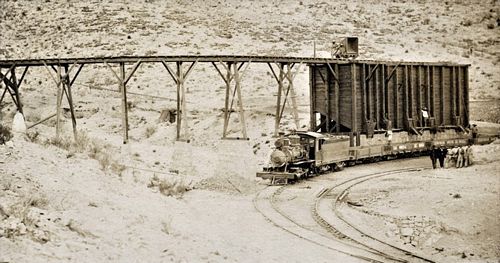
An American company was organised in Naica about 1903 and built its own narrow gauge railway from the Conchos station to the mine 20 miles away. In July 1911 the miners went on strike against the system of tickets (boletos) and deductions for non-existent medical facilities. The strike was settled through the intervention of Governor Abraham GonzálezEl Correo de Chihuahua, 24 June 1911: 16 July 1911.
Cusihuiriachi
Cusi Mexicana Mining Company
The Cusi Mexicana Mining Company was organised on 27 July 1911 and in 1912 bought the properties that had originally belonged to Herrera, González, Salazar y CompañiaThe properties had passed from Herrera, González, Salazar y Compañía to the Cusi Silver Mining Company in 1880, then to the don Enrique Mining Company (major shareholder Enrique Müller) in 1890, then Banco Minero in 1896 and finally the Helena Mining Company. AlmadaFrancisco Almada, Resumen de Historia del Estado de Chihuahua, Mexico, 1955. Worthington, op. cit., lists tokens: TIENDA DE RAYA / M. Co. / COSIHUIRIACHIC 1880 / 2 / REALES EN EFECTOS and the same design for 1/4, 1/2, 1 and 4 reales and 1 peso. mentions it as one of the companies that issued vales.
Ocampo (formerly Jesús María)
Compañia Minera La República
This mine was located in the district of Rayón, halfway between Ocampo (Jesús María) and La Bufa. It was discovered by a local miner, Manuel Amado, in 1894, who sold it to three gentleman, Gibbs, White and Alexander, from Miñaca. They in turn sold it to La República Mining Company, a company with a capital of $2,250,000 with the majority of shareholders from El Paso, Texas and Kansas City, Missouri, and its general offices in El Paso. In 1907 the general manager was M. B. Parker, from El Paso, who had been with the company since its inceptionFederico García y Alva, Album-Directorio del Estado de Sonora, 1905-1907, Hermosillo. J. J. Mundy was President and B. F. Darbyshire Secretary.
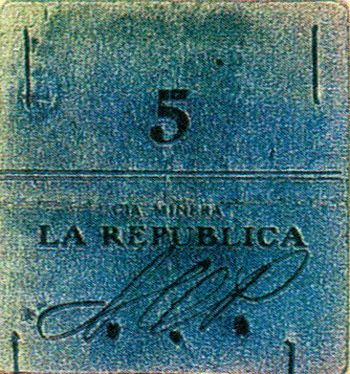
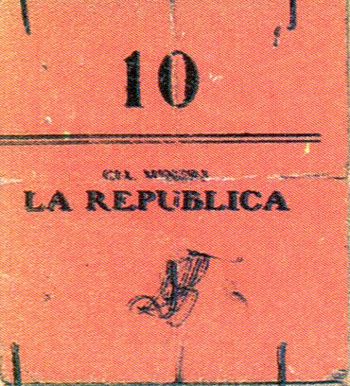
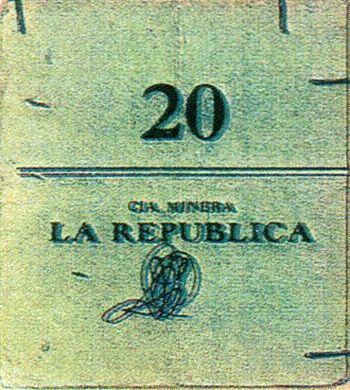

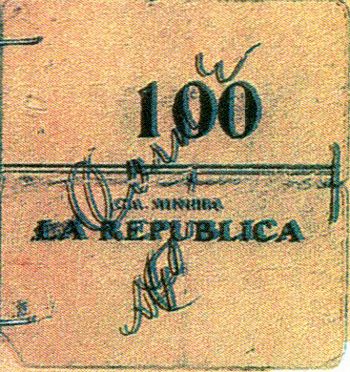
This company issued vouchers in at least five denominations – five (blue), ten (orange), twenty (green), fifty (beige) and one hundred (ochre) centavos. The 5c and 100c measure 60mm x 57mm whilst the other three values measure 64mm x 58mm. There are three different intials and the $1 note has 'carne' written on it.
| M. B. Parker, from El Paso, was the general manger from the company's inception. | 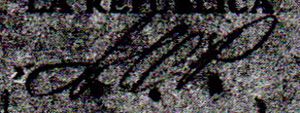 |
 |
|
 |
In 1908 the company was reported to the state government and on 2 October 1908 Secretario Guillermo Porras told the local authorities to apply the fine set by article 26 of the 1905 Monetary LawLuis Gómez Wulschner, Pre-Revolutionary vouchers of the mining company “La Republica”. A Numismatic Discovery in USMexNA Journal , September 2004.
In his report on local administration in 1908 the jefe político of Ocampo, José María Rentería, reported that various mining and mercantile companies had issued scrip (vales, bilimbiques y boletos) in place of using legal tender and that he had imposed some fines to halt the practiceFrancisco Almada, Apuntes Historicos del cantón Rayón, Mexico, 1943.
Palmarejo
In November 1905 it was reported that the Palmarejo mine had abandoned the practice of paying with coupons for meat (boletos de 400 gramos carne)[image needed]. If workers earned 50 centavos they were now paid in cash, whereas previously they had to earn five pesos before they were paid in cash. Some said that Don Reinaldo (Almada?) had stopped the practice, whilst others attributed it to the new managerEl Correo de Chihuahua, 9 November 1905.
Urique
In August 1911 a correspondent, Federico Aguilar, reported to El Correo de Chihuahua on the situation in Urique. The mine there had been under the control of an American, H. S. Durand, who paid workers in cash, but in April 1911 Alfredo S. Monge, an associate of Becerra, the local cacique, had bought the mine and began paying in merchandise, using a system of vales or boletos[images needed]. The correspondent hoped that once governor Abraham González learnt of this, he would put a stop to such illegal practicesEl Correo de Chihuahua, 20 August 1911.
Santa Bárbara
Moctezuma Lead Company
In Santa Bárbara the American-owned Moctezuma Lead Company issued its workers with boletas for use in the company storeEl Diario del Hogar, 22 January 1902. One such boleta was of red cardboard, measuring 12 by 7 centimetres. Along the top were ten little boxes with the numeral ‘5’ in each; along the bottom another ten with the numeral ‘1’; at the left five boxes with the numeral ‘10’ and at the right five with the numeral ‘2’compare a similar system of 'tick offs' on the Cananea notes. If the description is correct, the notes would have been for $1.20, so the description is probably wrong.. In the centre was the legend:
G
Montezuma Lead Company.
Boleta de identificación en la comisaría para empleados de la compañía.
No es negociable.
Ni se reconocerá esta boleta sino cuando se presente íntegra y por el empleado á quien se expida.
Nombre del empleado .............
Macared, rayador en jefe.
Minas de Tecolotes y Anexas
In Santa Bárbara, the Compañía de Minas de Tecolotes y Anexas maintained production despite the economic crisis and did not have either its own tienda de raya or arrangement with any casa comercial but paid regularly on paydays in cash. However, a certain employee of the company did make loans to the workers (at a interest rate of 10% per week) and issued vales for his grocery store, cantina and billiard palour. Anyone who did not accept his vales lost their jobEl Correo de Chihuahua, 11 February 1909: El Diario, 15 February 1909.
Parral
Minas Veta Grande y Anexas, Minas Nuevas
From 1907 many of the mines in Minas Nuevas (now Villa Escobedo), slightly north of Hidalgo del Parral, closed, with the exception of the “Veta Grande y Anexas”. In 1909 this mine was late in paying, and gave out boletos to be to be used in the expensive tienda de raya. Since the workers were receiving only a few centavos on paydays, the other shops in the area suffered and many closed, to the detriment of the local tax baseEl Correo de Chihuahua, 2 March 1909.
Compañía del Ferrocarril Parral y Durango (Parral and Durango Rail Road Company)
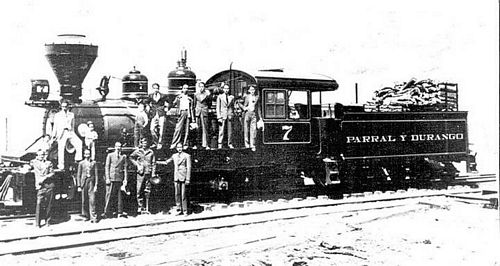
The Parral and Durango Rail Road Company was incorporated in Colorado in 1898 and owned the line from Minas Nuevas, Chihuahua to Paraje Seco, Durango, built under a concession granted on 29 June 1898. From Rincón it had a narrow gauge branch line to Parral, which connected with the Parral branch of the Mexican Central Railroad.
On 5 April 1912 the Orozquistas attacked the town of Parral. The Parral and Durango Railroad paid all the wages due for March in cash, being obliged to resort to many subterfuges in order to obtain and pay out the money but, as there were no longer any banking facilities in the town, it posted up notices[text needed] that wages from 1 April would be paid only by orders convertible into cash when normal conditions returned, or in merchandise. All the men without exception agreed to stay onSD papers, 812.00/3706 letter 8 April 1912.
The Alvarado Mining & Milling Company
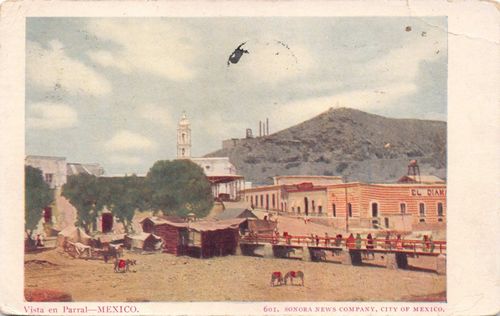
In April 1912 the Alvarado Mining & Milling Company took the same step as the Parral & Durango Railroad and posted identical notices[text needed]SD papers, 812.00/3706 letter 8 April 1912.
[ ]
J. B. Chandler
In May 1911 Governor Abraham González ordered railroad contractor J. B. Chandler, of Kilometre 88, Ferrocarril Noroeste de México, to stop paying his employees with cardboard tokens (cheques de cartón) and henceforth to pay them in cashPeriódico Oficial del Gobierno Provisional de los Estados Unidos Mexicanos, Num. 2, Ciudad Juárez, 25 May 1911.

